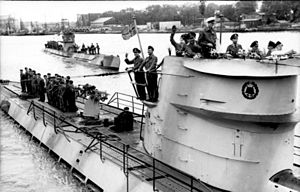 U-123 and U-201 departing Lorient on 8 June 1941
| |
| History | |
|---|---|
| Name | U-201 |
| Ordered | 23 September 1939 |
| Builder | Germaniawerft, Kiel |
| Yard number | 630 |
| Laid down | 20 January 1940 |
| Launched | 7 December 1940 |
| Commissioned | 25 January 1941 |
| Fate | Sunk, 17 February 1943 by HMS Viscount |
| General characteristics | |
| Class and type | Type VIIC submarine |
| Displacement | |
| Length |
|
| Beam |
|
| Height | 9.60 m (31 ft 6 in) |
| Draught | 4.74 m (15 ft 7 in) |
| Installed power |
|
| Propulsion |
|
| Speed |
|
| Range | |
| Test depth |
|
| Complement | 4 officers, 40–56 enlisted |
| Armament |
|
| Service record[1][2] | |
| Part of: |
|
| Identification codes: | M 33 584 |
| Commanders: |
|
| Operations: |
|
| Victories: | |
German submarine U-201 was a Type VIIC U-boat of the Kriegsmarine in World War II.
The submarine was laid down on 20 January 1940 by Friedrich Krupp Germaniawerft yard at Kiel as yard number 630, launched on 7 December 1940, and commissioned on 25 January 1941 under the command of Kapitänleutnant Adalbert Schnee. Attached to the 1st U-boat Flotilla, she made nine successful patrols in the North Atlantic, the last two under the command of Oberleutnant zur See Günther Rosenberg. She was a member of eight wolfpacks.
She was sunk on 17 February 1943 in the North Atlantic, by depth charges from a British warship. All 49 hands were lost.[1]
- ^ a b Helgason, Guðmundur. "The Type VIIC boat U-201". German U-boats of WWII - uboat.net. Retrieved 19 February 2010.
- ^ Helgason, Guðmundur. "War Patrols by German U-boat U-201". German U-boats of WWII - uboat.net. Retrieved 19 February 2010.